


For optimal viewing, set your browser's "View" to Full Screen. Click on any of the images for a larger view. Your browser will automatically downsize the large picture to fit your computer monitor screen. We resized all photos to the standard high definition television height of 1080 pixels or higher so that they will completely fill the height of a 1080 HDTV screen because we think many people will soon connect their computers to new widescreen HDTVs, and some people will want this large picture size. Unless otherwise noted, please ask permission from the photographers if you want to use their photos.
The term "stained glass" commonly refers to any colored flat glass or any object made of this glass joined by metal strips. The term originally applied to colored or clear flat glass cut to fit an artist's design, on which details were painted with a brush using glass enamel. The glass pieces were then heated in a kiln or oven to bond and fuse the enamel to the glass surface. This firing made the painted detail as durable and permanent as the glass itself. Most stained glass sundial and religious windows from medieval times until this century were executed in this manner. In our website, we use a broader definition that includes glass colored by any means including inks and non-fired enamels. Etched glass is not stained glass. But we included a separate etched glass section in the Image Archive since they are so similar in function and use. Some sundials have both stained and etched glass pieces in them, making them difficult to classify, so I follow this rule: If most of the sundial is of stained glass, then I put it in the stained glass section, otherwise I classify it as etched glass.
 |
 |
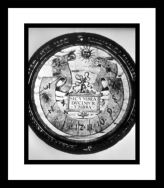 |
| Maker: unknown Date: 1529 Original Location: somewhere in Germany. Reverse engineering of dial face by Gianni Ferrari puts the design location roughly at Lat: 44.9° N. which is in the far south of Germany in 1529. Present Location: Adler Planetarium & Astronomy Museum, 1300 South Lake Shore Dr. Chicago, Illinois 60605 USA Orientation: Vertical. Declines 13.3 east of south Size: round- 27.9 x 27.9 x 0.9 cm (11 x 11 x .4 in) Adornment: zodiacal signs and the letters- H.V.R.A.J Mottos: none Condition: excellent despite its age Comments: This was probably made for use as a window hanging. It is the oldest known stained glass sundial in the world. It is unknown when, how and from whom Adler Planetarium acquired this valuable historical piece. We’d love to find out more details of its long history. Adler Planetarium Website: Here Igougo Website: Here Photo Descriptions: Photos ‘a’ and ‘b’ © Adler Planetarium & Museum. Photo ‘c’ was taken by kwasiak and copied from igougo website below. Photo ‘d’ is a map of Germany (1530) from unknown source. Photos: a b c d |
Maker: unknown. There are no records regarding the artist who was presumeably a Swabian artist. Date: 1550. Since the Roman numerals MDL = 1550 are indicated on the glass plate it is assumed that the sundial was created then. Original Location: Lat- 47° 15 ' 23 " N, Lon- 11° 26 ' 02 " E. Window of a chapel on the eastern side of the castle. The chapel does not exist anymore. Ambras Castle near Innsbruck Austria. Swabian origin, Germany Present Location: René R.J. Rohr said that it was in the Museum Fürangewandte Kunst (The Museum for Applied Art in Vienna Austria) in Wien, Austria. Ref: "Les cadrans solaires" (Histoire, Théorie, Pratique), Editions Oberlin, Strasbourg (1986). Thanks to recent investigations made by Elisabeth Druml in 2009, she confirms that it is currently stored in the museum archives and is unfortunately not on display. Today (2009), the stained glass sundial is kept in the archive of the Museum of Applied Arts in Vienna. Many art treasures of the Castle of Ambras were moved to Vienna to keep them safe when Tyrol was conquered by the troops of Napoleon and the Bavarians. The sundial is still stored there. The glass sundial is kept under the inventory number 2808 in this museum. Orientation: Vertical. Declines 16.8° west of south Size: round. Plate Diameter- 38.5 cm (14.9 in) Adornment: angel head and putto with heavens globe, astronomical instruments and small block dial. Fly in chapter ring at 9:45 (legs and body on outside and wings on inside) Inscriptions: Above the dial an explanation or instructions for using the sundial are provided, the second part of which continues annularly around the dial. (See pdf attachment for details). Mottos: undetermined Condition: fair. Gnomon with sphere is missing. Comments: Has three different time notations. Day and night lengths 8-16 are beneath noon line. It is presumed that the former owners of the castle, the Schurf family, gave the order for this sundial. The inscription suggests Swabian origin due to vernacular characteristics. In 1563, archduke Ferdinand II (1529-1595) acquired the castle of Ambras. At the same time he advanced to Prince of Tyrol according to the last will of his father emperor Ferdinand I. A year later he signed over the Castle of Ambras to Philippine Welser, a woman of a middle class family in Augsburg, he was secretly married to. We are deeply indebted to Karl Schwarzinger for sending us updated information and photo ‘g’ showing the original dial. References: Harro H. Kühnelt: “Die Glasmalerei – Sonnenuhr des Museums für Angewandte Kunst in Wien, Schriften der Freunde alter Uhren 1972/73, Heft XII”. Hans Behrendt : “Glas – Sonnenuhren“, Schriften der Freunde alter Uhren 1980, Heft XIX. An article on the stained glass sundial of the Castle of Ambras may have beed published in the bulletin "RUNDSCHREIBEN" of the Working Group for Sundials in the Austrian Astronomical Society. Karl Swarzinger’s Ambras Castle SGS Info Pages: Here Behrendt VHS Transcript: Here Vienna Museum’s Website: Here Encyclopedia Website: Here Photo Descriptions: Photos ‘d’ and ‘e’ are of a German 20th century window hanging reproduction and are from unknown source. Photo ‘f’ ©: MAK/Georg Mayer. Mrs. Dr. Ilse Fabian from the Working Group Sundials in the Austrian Astronomical Association has been given opportunity to photograph the original stained glass sundial. This photo was kindly sent to us by Karl Schwarzinger. Photos: a b c d e f |
Maker: unknown Date: 1535 Original Location: pane was in Kunstgewerbemuseum (Museum of Applied Art) in Berlin Germany Present Location: unknown. now missing Orientation: Vertical. Declines south-southeast. Size: unknown. round Adornment: a time ribbon from 6am to 4 pm. a sun, laurel wreath framing. Mottos: "Sic Umbra Ducimur Umbra" (Like the Shadow, We will be Guided by the Shadow) Condition: unknown. Gnomon hole is present. Comments: We need more information and better photos of this great lost dial. If you find it, please let us know! Videotape Transcript of Dial 141 only: Here Willy Bachman’s Email: Here Photo Descriptions: Photo ‘a’ was kindly sent to us in 2008 by Willy Bachmann from Germany. It is a copy from the "Bildarchiv des AK Sonnenuhren in der Deutschen Gesellschaft für Chronometrie e. V. (DGC)". This photo may be an old (1950’s?) reproduction. Photo ‘b’ was photographed from a still frame from the videotape movie by Hans Behrendt called "Historische Glassonnenuhren" 1980. It is probably a copy of photo ‘a’. Other poorer quality photos exist in the German Archive. Photos: a b |
 |
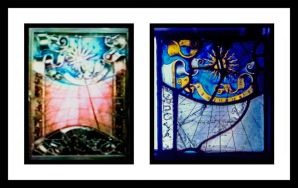 |
 |
| Maker: Bernhard Dininckoff, member of York School of Glass Painting Date: 1585 Original Location: The Great Chamber of Gilling Castle, York, North Yorkshire, England Present Location: original site Orientation: Vertical. undetermined Size: unknown Adornment: undetermined Mottos: Latin mottos are present in scrolls on the left and right sides, but they are difficult to read. Condition: fair. Glass is cracked. Some cracks have been re-leaded. Gnomon is present. Comments: Magnificent heraldic window contains the oldest known English painted Glass Sundial. The windows of the room show the genealogy and heraldry of the Fairfax family. Signed and dated by Dininckoff. A tiny portrait of him is below sundial. We urge anybody who might be visiting York England to please investigate this wonderful dial for us and get us some more photos. Article by Geoffrey Lane (6 MB): (2006) Glass Sundial Makers of 17th Century London. "The British Sundial Society Bulletin" Vol. 18(i), March 2006. 40-47 Article by Christopher Daniel: (2004) “Sundials” a Shire Book Article by Christopher Daniel (2 MB): (1987) Shedding a Glorious Light. "Country Life" 181, 72-75 Gilling Castle Website: Here Photo Descriptions: Photo is courtesy of Christopher Daniel © C StJ H D. Photos: a |
Maker: unknown Date: 1576 Original Location: pane from castle Friedrichshafen, later the monastery Bebenhausen/ Tubingen. Germany. Lat: 47.7° N. Present Location: now in the archive of the Castle Altshausen in Saulgau Germany. It’s unknown when it was removed from its original location. Orientation: Vertical. Declines south. Size: unknown Adornment: chapter ring 8am-12-5 pm, below- table with hour and zodiacal lines. Day and night lengths 8-15 and 9-16 beneath are the meridian line. shining sun, zodiacal signs, right and upper part missing Inscription: Isaac...Fiessen, pict- Spire-fec... In the ribbon- MDLXXVI (1576) Condition: Photo ‘b’ shows that the dial was cracked then re-leaded. We don’t know when this happened. Comments: We need more information and better photos of this historic and valuable dial. If you find it, please let us know! It would be well worth the effort (and fun!) if somebody would visit the archive of the Castle Altshausen in Saulgau Germany to find out if it still exists and to get us better photos and more information about it. Videotape Transcript of Dial 142 only: Here Altshausen Website: Here Willy Bachman’s Email: Here Photo Descriptions: Photo ‘a’ was photographed from a still frame from the videotape movie by Hans Behrendt called "Historische Glassonnenuhren" 1980. It shows the dial before it was cracked and re-leaded. It has a gnomon shadow at 10:30 am. Consequently, this photo probably shows the dial in its original location. Photo ‘b’ was kindly sent to us in 2008 by Willy Bachmann from Germany. It is a copy from the "Bildarchiv des AK Sonnenuhren in der Deutschen Gesellschaft für Chronometrie e. V. (DGC)". This photo may be an old (1950's?) reproduction. Other poorer quality photos exist in the German Archive. Photos: a b |
Maker: Signum MP (Martin Pfender - Rottweil municipal glasser) Date: 1553 Original Location: In the conference room wall of Rottweil Town Hall, Wurtemberg Germany Present Location: at original location Orientation: Vertical. Declines southeast. Size: 44.5 x 34.5 cm (17.5 x 13.5 in) Adornment: Architectural arch and figures making music is in the pillars. Over the arch is an apple shooting scene from the theatre play Wilhelm Tell by Friedrich Schiller. There’s an angel and lion's head. Below is a shining sun over arms with the eagle of the imperial town, Rottweil. There are angels blowing trombones. Mottos: "Die Zeit" (The Time) Condition: Fair. Pane with lead frames and leaded cracks, Gnomon is broken out. Comments: Chapter ring has hour lines 5-12-5 and 1/2 hour divisions. Zodiacal lines only symbolic, parallel to depth direction. Day & night lengths 8-16 are beneath meridian line. Hour lines apparently not calculated but applied according to observations during different seasons, because the lines 5-5 are not in line. Visits only on request at the Tourist Information. We urge anybody who might be visiting Rottweil to please investigate this wonderful dial for us and get us some more photos. Behrendt VHS Transcript: Here German Clock Route Website: Here Photo Descriptions: Photo ‘a’ is the original from an unknown source. Other photos are photoshopped verisions of photo ‘a’. Photos: a b c |
 |
||
| Maker: Hans Harderbeck 2009 Gnomon Restorer: Ulrich Weyer, Elbestr. 1, 89231 Neu-Ulm, Germany Date: c. 1540 Original Location: Lat: 48° 24´ N. (from GPS) Lon: 9° 59’ E. In an old Book (Geburtsstundenbuch) from 1572 the latitude of Ulm is quoted with 48° 26´. The sundial is in the east wall of the little conference hall of Rathaus (City Hall), Marktplatz 1, Ulm Germany Present Location: at original location Orientation: Vertical. Declines east. Size: 62 x 42.5 cm (24.4 x 16.7 in) Adornment: On the left side is a knight in his armour with the banner of the German emperor and on the right side a mercenary with the black and white stripes banner of Ulm. The adjacent windows show the coats of arms of important aldermen and families of the free imperial city of Ulm. The shield with the black and white colors is the coat of arms of Ulm, the shield with the double headed eagle is the coat of arms of the emperor of the Holy Roman Empire of German Nation. Mottos: Original text- “Es stirbt der herr mit sampt dem knecht, Der frum(m) und auch der ungerecht, Unnd niemand wird am morgen geben, Zu wissen dises Aubens leben, Unnd ehe der mensch das recht befindt, Stund tag und Jar vergangen sind” (Trans- The Lord will die and equally the servant, The pious and the unjust man, And nobody will claim in the morning, To be still alive in the evening, And ere man comprehends this totally, Hours, days and years have gone) Condition: Very good considering its great age! It has been cracked and re-leaded at some unknown date in the past. The gnomon has been restored at least once at an unknown date before 2004. But the ‘L’shaped gnomon had an incorrect orientation when it was inspected in 2009 by German professor, Ulrich Weyer (see photo ‘f’). Thanks to Mr. Weyer’s admirable efforts, The Lord Mayor of Ulm, Ivo Gönner, gave him permission to construct a new gnomon and to orient it correctly. It is a rectangular bar (400 mm x 19 mm x 2 mm). The edge next to the protective glass is toothed, and the top edge is plane. One reads the time from the shadow cast by the top smooth edge. Reading the bar shadow is a bit confusing, because it means that before VI you read the right (south) side of the shadow, at exactly VI you read the center of the shadow, and after IV you read the left (north) side of the shadow. His team constructed the gnomon in such a way that they can adjust the distance to the glass pane and the angle a little bit. In July 2009 he told us that he is measuring the distance of the shadow from the 6 o’clock line at different times in order to adjust the gnomon precisely. The investigation will take some time. Comments: This is the world’s second oldest known stained glass sundial and is one of the world’s finest and most adored old sundials. It is the oldest stained glass sundial known that is still in sitio in its original location. It is one of my personal favorites (jc). The sundial is protected by an exterior clear glass pane. The new gnomon is 76.5 mm above inner side of the sundial. We’d like to thank Ulrich Weyer for his loving attention to restoring this fine old historical sundial. Hats off to him! We are most grateful for the new photos he sent us. Behrendt VHS Transcript: Here Baden-Wuerttemberg Website: Here Ulm Website: Here Flickr Website: Here Flickr Website: Here Flickr Website: Here Ulrich Weyer’s Email: Here Photo Descriptions: Photo ‘a’ is from an unknown source and we acquired it around 2004 I think. Photos ‘b’ to ‘l’ were taken by Ulrich Weyer in 2009 and were kindly sent to us by him. Photo ‘b’ is an interior photo that shows the shadow from the 2009 restored correctly aligned gnomon. Photo ‘c’ shows all the interior windows along the interior east wall of the little conference room. Photo ‘d’ shows magnificent east side windows and building from the exterior with five human figures- the central figure is of Emperor Charles the Great flanked by a german shield bearer on the left side and a french shield bearer on the right. On the far left is the king of Hungary and on the far right the king of Bohemia. Photo ‘e’ shows the previous bent gnomon with the wrong orientation. Photo ‘f’ shows sundial window with the new gnomon and the gorgeous central figure of Emperor Charles the Great. Photos ‘g’ to ‘l’ show the windows close-up from the interior. Photo ‘m’ is an old photo of the Rathaus copied from an unknown website. Photos ‘n’, ‘o’, ‘p’ are from the Flickr websites above. Photo ‘q’ is an analysis done by John Carmichael comparing the sundial to Shadows Pro sundial generator program drawings to determine the correct placement of the new gnomon. This verifys that Ulrich Weyer’s calculations were correct. Please ask photographers permission to use their photos. Photo ‘r’- shows the new gnomo. Photo ‘s’- shows measurements of time lines. Photo ‘t’- shows the new gnomon’s shadow Photos: a b c d e f g h i j k l m n o p q r s t u |
 |
 |
 |
| Maker: unknown Date: unknown Original Location: unknown location in England Present Location: Brought to the beautiful Lacock Abbey in the 18th or 19th century by the owner at the time who asked his friends for, or otherwise acquired, some stained glass fragments to help with the decoration. Orientation: Vertical. Declines west. Size: unknown Adornment: a fly Mottos: none Condition: poor. cracked, gnomon missing Comments: Unusual heraldic shield shape. Dial has been crudely restored but Alfred Fisher told me in November 2005 that it will be restored again using modern techniques to remove the previous restoration lead. Mr. Stephen Clare at Holy Well Glass in Somerset England will be performing the restoration. This sundial must have been one of a set of at least 2 because if you examine the photograph you will see that there is an inserted fragment (on the left) of a SOUTH dial of the same pattern. Installed in a wall that faces in the opposite wrong direction. Article by Christopher Daniel (5 MB): (Apr 1988) Stained Glass Sundials in England and Wales. "Clocks" 10, 30-37 Lacock Abbey Photos Website: Here Britain Express Website: Here Holy Well Glass Website: Here Alfred Fisher’s Email: Here Stephen Clare’s Email: Here Photo Descriptions: Photos ‘a’ and ‘c’ are courtesy of Christopher Daniel © C StJ H D. Photo ‘b’ is courtesy of Alfred Fisher and was taken in 2005. These photos are poor copies of copies, and they have been damaged by over-zealous photoshopping. We need better photos and updated information of this dial. Please help! Photos: a b c |
Maker: unknown Date: unknown, 17th century Original Location: unknown location in England Present Location: In south wall stairway window at The Museum of the History of Science, Oxford England. Orientation: Vertical. Designed for a window facing about 55° East of North. Size: 25 x 25 cm (9.8 x 9.8 in) Adornment: goldfinch on perch between 8th and 9th hour lines. The arms (bottom right) were granted to Edward Hayward of the inner temple in 1611. Mottos: “Vesper In Ambiguo Est - Age(N)Dum - Mora Noxia - Cras Nil” (The evening is uncertain - Come now! - Delay is harmful - Tomorrow is nothing) Condition: cracked. Gnomon is missing. Comments: We wonder where its original location was. Article by Christopher Daniel (5 MB): (Apr 1988) Stained Glass Sundials in England and Wales. "Clocks" 10, 30-37 Museum of The History of Science, Oxford Website: Here Photo Descriptions: Photos are courtesy of John Carmichael (2004). Anyone may use these photos without permission. Photos: a b |
Designer & Maker: unknown Date: unknown, 1600's. Original Location: unknown. Somewhere in Europe Present Location: unknown Orientation: Vertical, Declination is unknown exactly, but declines about 45° east of south. Size: 15.5 x 13.4 cm (6.125 x 5.25 in) Adornment: not signed, the hour numerals marked on banners are crossed by lines marked with pairs of zodiac symbols for reading the Sun's position and so the season. Above the upper banner is a sunburst carrying the Jesuit 'IHS' symbol. (Jesus, Savior of Man) Mottos: In the top left corner, is the motto, also marked on a banner, “FVGIT IRREPARABILE TEMPVS” (Time Passes Never to be Retrieved). In the bottom right corner is a second motto “DICO LVCIDAS TACEO NVBILAS” (in the Light I Speak, in the Cloud I Keep Silence). The first motto on the instrument derives from Virgil, Georgics III, 284-5 "Sed fugit interea, fugit irreparabile tempus, Singula dum capti circumvectare amore" (But meanwhile time flies, flies irretrievably; While we, love stricken, dwell on each thing) Condition: good. It’s unknown if gnomon exists. Comments: Oddly, the numbers incorrectly show afternoon hours although the dial declines towards the east. Dial lines, motto in lower right, and painting is sloppy, though attractive. Sold at Sothebys auction in London Oct 02 by Absentee Bid Form for 2,115 GBP. Provenance- The Blumka Collection; UTO Auktionem, Auktion von 13 November 1978, Zurich 1978, lot 175; The Time Museum Inventory No 1543. We need more information and better photos of this now lost dial. Photo Descriptions: Photo was copied from Sotheby’s temporary webpage- now unavailable. Photos: a |
 |
 |
 |
| Maker: These letters on the dial are probably the initials of the maker- “S. S.” His name is unknown. Date: 1649 Original Location: unknown location in England Present Location: Family married into Bucklebury and brought the dial with them reinstalling it in the north window of Parish church of St. Mary, Bucklebury England at Lat: 51° 26' N. Lon: 01° 12' W. Orientation: Vertical. Declines 13° west of south. Size: square- 30 x 30 cm (11.8 x 11.8 in) Adornment: The coats of arms of the families of Stephens and Stone. Mottos: Signed “S.S- me fecit” and “Th- S & St” Condition: cracked Article by Geoffrey Lane (6 MB): (2006) Glass Sundial Makers of 17th Century London. "The British Sundial Society Bulletin" Vol. 18(i), March 2006. 40-47 Article by Christopher Daniel: (Dec 2006) An Unsolved Mystery. The Sundial Page, "Clocks" Vol. unknown Article by Christopher Daniel (2 MB): (1987) Shedding a Glorious Light. "Country Life" 181, 72-75 Burkshire History Website: Here Church of England Website: Here Flickr.com Website: Here Photo Descriptions: Photos ‘a’ to ‘h’ are courtesy of Mike Cowham (2007). Photos ‘i’ and ‘j’ are courtesy of Jo Parsons from her Flickr website posting. (see website above) Photos: a b c d e f g h i j |
Maker: unknown Date: probably 1600's Original Location: Lat: 52° 32' N; Lon: 0° 50' E. 2 meters above the ground in a south aisle window east of south porch at St. Peter's Church in Merton, Norfolk England Present Location: Not in its original window, but may have been for this church originally. Installed in the Victorian period. Orientation: Vertical. Declines east. Size: Outside of came- 18 x 15.3 cm (7 x 6 in). Overall panel- 38 x 33 cm (14.9 x 13 in) Adornment: in the upper left corner a spider on web is busy catching a fly painted on inside. Queens portraits surround dial. That on the extreme left has replacement glass. Three white circles in hour borders are not holes, just clear areas. St Peter's Key panel. A matching panel in the next window has the same surround and the St. Peter's keys. Physical key to church has similar shape Mottos: "dum loquimur fugit hora" (while we talk, time flies) Condition: Fair. Some old breaks repaired in the 1800s. Needs cleaning. Gnomon missing. Behrendt's videotape (1980s) shows two missing red border panes in the upper right that have been repaired since then. Comments: Restricted access. To view, contact Mr. David Kay (church warden) for key at 01953 881 339. Article by Christopher Daniel: (Dec 2005) Sundials of the British Isles. The Sundial Page, "Clocks" Vol. unknown Videotape Transcript of Dial 155 only: Here Merton Website: Here Photo Descriptions: All photos were taken in Sept. 2004 and are courtesy of and © by John Davis. Photo ‘j’, shows the dial before (left) and after (right) restoration. Photos: a b c d e f g h i j |
Maker: prob. by Richard Dutton (1640-1686) Date: 1671 Original Location: The Pewterers' Company, London England Present Location: unknown, probably destroyed Orientation: Vertical. Declines south. Size: unknown Adornment: classical pediment. Pediment may have extended into adjacent panes. A spider advances on a fly Mottos: "Sic Vita" (So is Life) Condition: probably destroyed in World War II Comments: Painted for The Pewterers' Company. This information is from the Geoffrey Lane article. We need a good copy of the original photo and other photos if they exist. Does anybody know where it is? Article by Geoffrey Lane (6 MB): (2006) Glass Sundial Makers of 17th Century London. "The British Sundial Society Bulletin" Vol. 18(i), March 2006. 40-47 Photo Descriptions: Photographed in 1902. Original photo that appeared in a history of the company, is now at The Society of Antiquaries. This photo is scanned from Geoffrey Lane's article (see link above). Photos: a |
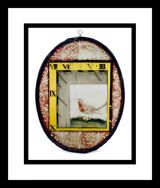 |
 |
 |
| Maker: possibly John Oliver Date: 1650 Original Location: Carmichael thinks it was made for an unknown location in England, but Sotheby's says it could be Swiss. Present Location: unknown. Sold on Oct 14, 2004 at Sotheby auction to unknown buyer. Previously was at the now closed Time Museum in Rockford Illinois, USA. Orientation: Vertical. Declines northeast of south. Size: 27.5 x 21 cm (11 x 8 in) Adornment: scrollwork on red background and a singing English robin (robin redbreast). Inscription: none. unsigned Condition: cracked. Gnomon missing Comments: Dial must have been originally installed in some window since the photo shows gnomon holes in the glass. Therefore, the wire hanging loop must have been added after the dial was removed from its window. It sold for 3000 USD at Sothebys. Time Museum Inventory #98. Sotheby lot #761, Sale # 1103039. Dial also appears in a videotape movie and transcript by Hans Behrendt called "Historische Glassonnenuhren" 1990. If anybody knows where this dial is located or has more photos, please tell us. Videotape Transcript of Dial 150 only: Here Photo Descriptions: Photo ‘a’ is a corrected reverse image of the lot photo from the Sotheby auction website. Carmichael thinks that the dial was photographed backwards by Sothebys. Photo ‘b’ is from Hans Behrendt’s videotape. Photos: a b |
Maker: It was originally thought that the signed maker's initials "W.P." referred to William Price or his father. Chris Daniel thinks it is probably by William Pollicott. Date: 1655 ("Feb. V (?) A. D. DMDCLV"). Companion window says- "This Fabricke was new erected, Ao-1655. Robert Harper, & John Pride then Church wardens." Original Location: The London parish church of St. Clement Danes, England. Present Location: In private collection at undisclosed location in England. Attractively displayed in the living room on a wall-mounted electric light box. Orientation: Vertical. Declines east of south. Size: 34 x 57 cm (13.3 x 22.4 in) Adornment: various heraldic designs Mottos: "LVMEN UMBRA DEI" (Light is God's Shadow), and “Hoc fieri fecit vitrum” (quod pignus amoris) “Febr V(?) Ao-D-MDCLV. W. P.” Condition: fair but cracked Comments: Also called "The St Clement Danes Dial". Signed and dated MDCLV. Restored in June 29th 1816 by Anthony (?) Henderson. Restored again in 2004 by George Wigley, Monastery Stained Glass using epoxy method to eliminate old 1816 repair came which exposed the cracks. The owner wishes to remain anonymous. John Carmichael saw this dial in person in 2006 and says that it is being well-cared for by its owner and is beautifully displayed. Another box displays the Companion window. It is in good hands. Article by Geoffrey Lane (6 MB): (2006) Glass Sundial Makers of 17th Century London. "The British Sundial Society Bulletin" Vol. 18(i), March 2006. 40-47 Article by Christopher Daniel: (Jun 2004) St Clement Danes. The Sundial Page, "Clocks" Vol. 27/6 Photo Descriptions: Photo ‘a’ shows dial after 1816 restoration. Photo ‘b’ shows dial after 2004 restoration. Photo ‘c’ shows the Companion Window. Photo ‘d’ is photo ‘a’ but with a black background. Photo ‘e’ shows the gnomon hole. Photo ‘f’ shows photos ‘a’ and ‘c’. The photographer wishes to remain anonymous but says that anyone may use these photos. Photos: a b c d e f |
Maker: John Oliver (1616-1701) Date: 1664 or 1665 Original Location: somewhere in England Present Location: Unknown exactly. Last known to be in a private collection in the late 1900 in Southport Ct USA. Orientation: Vertical. Declines west Size: unknown Adornment: a fly Mottos: "non sine lumine" (Not without light) Condition: unknown Comments: by Mr. Lane: “Designed like a mathematical scale. The style of the inscription appears on a number of dials attributed to John Oliver.” If anybody knows where this dial is located or has more photos, please tell us. Article by Geoffrey Lane (6 MB): (2006) Glass Sundial Makers of 17th Century London. "The British Sundial Society Bulletin" Vol. 18(i), March 2006. 40-47 Photo Descriptions: Photos are courtesy of Geoffrey Lane from his BSS Bulletin article (see link above). Photos: a b |
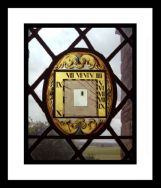 |
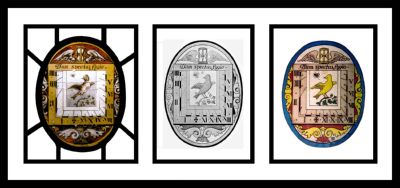 |
 |
| Maker: probably by John Oliver (1616-1701) Date: 1600's Original Location: In the private chapel's window, Berkeley Castle, Gloucestershire UK Present Location: at original location Orientation: Vertical. Declines about 70° east of south. Size: oval- 25.5 x 21 cm (10 x 8.2 in) Adornment: simple flowing designs, a fly on raised thick outside of glass Mottos: none Condition: excellent, shows hours 4 to 10am Article by Christopher Daniel: (2004) “Sundials” a Shire Book Article by Christopher Daniel (5 MB): (Apr 1988) Stained Glass Sundials in England and Wales. "Clocks" 10, 30-37 Berkeley Castle Website: Here Flickr Website: Here Photo Descriptions: Photos ‘a’, ‘b’, are © courtesy of Carol Arnold taken in 2002. Photo ‘c’ is courtesy of Christopher Daniel © C StJ H D and is photocopied from his article and photoshopped. Photo ‘d’ is a notebook sketch by unknown artist. Photo ‘e’ is courtesy of Tim Davies from the Flickr website above. Photos: a b c d e |
Maker: probably by John Oliver (1616-1701), but there isn't direct evidence to support it. Date: 1686 Original Location: Lat: 51.43° N; Lon: 2.75° W. In the Langford Room at Nailsea Court, Somerset (Avon) England Present Location: stolen from Nailsea Court, present location unknown. Orientation: Vertical. Declines about 35° East of South Size: 26.1 x 18.7 cm (10 1/4 x 7 3/8 in) Adornment: bird on branch looks at fly, winged hourglass, ornamental cartouche Mottos: Dum Spectas Fugio (While you Watch I Flee) Condition: cracked. Gnomon hole in glass Comments: The Nailsea Court dial, one of England's most famous sundials, is frequently copied & recopied. Now lost. In January 2007 a replacement reproduction made by Carol Arnold was installed at Nailsea Court in the original window. See photos of it on the 21st century page of this website- Dial 367. Article by Christopher Daniel: (2004) “Sundials” a Shire Book Article by Chris Daniel: ‘Bird in Hand’ from "Clocks" magazine, Vol. 24/9, Oct 2001 Description of Carol Arnold's Reproduction Prototype: Here Nailsea Court Website: Here Carol Arnold's Reproduction Website: Here Replacement Reproduction (Dial 367): Here Photo Descriptions: Photo ‘a’ is courtesy of Christopher Daniel © C StJ H D and photo ‘a’ is the original Nailsea Court dial. Photo ‘b’ is courtesy of Antonio J. Cañones and is a drawing by Wilfred Drake of the Derby dial which was last reported to be in the A. L. Radford collection in New York. The Derby Dial is a good 1888 reproduction by Frederick Drake that was made for Derby England. Photos ‘c’ and ‘d’ are a dial that was recently discovered in New York and purchased for private collection in Spain- this might be a copy of the Derby Dial. It's 30 cm tall with painting on both sides and hangs from a chain. Photo ‘e’ and ‘j’ are of Carol Arnold’s St Michaels Dial- the replacement prototype (Dial 223). ‘Photo ‘f’’ is the building. Photo ‘g’ is close-up of original dial. Photo ‘h’ is a 1923 sketch of The Langford Room showing the dial's original location. Photo ‘i’ is of entire window group. Photos: a b c d e f g h i j |
Maker: prob. John Oliver (1616-1701) Date: 1652 Original Location: somewhere in England Present Location: Roy Grossvenor Thomas Collection Orientation: Vertical. Declination is undetermined. Size: unknown Adornment: fly, hourglass, wings Mottos: "Tempus dax rerum" (Time, the devourer of all things) Condition: unknown Comments: We are looking for more information and better photos of this dial. Behrendt VHS Transcript: Here Photo Descriptions: Photo is from unknown source. Photos: a |
 |
 |
 |
| Maker: Possibly John Oliver (1616-1701) Date: mid 1600's Original Location: The deconsecrated redundant St Dunstan's Church in nearby Wenden Lofts England. Present Location: Salvaged and rescued from the deconsecrated St Dunstan's Church in 1958. Dial now resides in the St Nicholas' Church, Elmdon, Essex, in the East window of the South aisle. Orientation: Vertical. Declines about 5° west of south Size: estimation- 25 cm x 19 cm (10 x 7.4 in) Adornment: Wings and hourglasss, scrollwork with motto. Mottos: “Sic Vita” (Such is life!), “Nulla dies sine linea” (No day without a line) Condition: In 2005 it was fair. Gnomon is missing. Comments: A reproduction of this dial was made in 2005 by Grace Wallis. See Dial 230 in the 21st Century section of our Image Archive. The pub across the road is called 'The Elmdon Dial' and has a sign that is a good likeness of the original. The Elmdon Dial Pub Website: Here The Elmdon Church Dial Replica: Here Photo Descriptions: courtesy of Mike Cowham and John Carmichael. Photos ‘a’ to ‘g’ show the dial. Photo ‘h’ is the plaque. Photo ‘i’ is the sign of the pub across the street from the church. Photo ‘j’ is the Elmdon Dial Pub entrance. Photos: a b c d e f g h i j |
Maker: Unknown, possibly John Oliver (1616-1701) Date: Possibly 1653 Original Location: in the upper centre window of the Paneled Chamber 20 ft. (6m.) above ground level at The Merchant's House, Marlborough, Wiltshire England. Present Location: at original location, Marlborough England Orientation: Vertical. Declines about 45° East of South Size: 18.7 x 22.2 cm (47.5 x 8.7 in) Adornment: Golden scroll surrounds dial face. Fly in empty inner field whose left side margin is the meridian line. Tendrils are on margin. Angel heads are on left and right. Below is a horned face mask. Mottos: "Dum Spectas Fugio" (While you watch, I fly), "Sic Vita" (So doth life) Condition: Original bolted gnomon and mounting bar was struck by lightning sometime before 1863 when Gatty sketched the dial, and it fell off, cracking the glass. Cracks were re-leaded sometime in the late 1990s by an unknown glazier. In July 2004 restorers (BSS dialists David Brown & Peter Walker) installed an improvised replacement 4 mm stainless steel rod gnomon painted with green enamel. It's attached to a vertical support stay that's screwed to the building's wood molding above the dial. Small screws at the top of the stay helped the installer to properly adjust the gnomon's position. Gatty's sketch shows the top decorative pane which no longer exists. Comments: Gatty mentions the superb realistic painting of the fly- “the wings were painted on one side of the glass while the body and legs were on the other side, so as to deceive the spectator". The number "45" is scratched to the outside of the glass near the gnomon attachment point and is probably the dial's declination. Article by Christopher Daniel (5 MB): (Apr 1988) Stained Glass Sundials in England and Wales. "Clocks" 10, 30-37 Gatty Article from Book: Here Gatty Book: Gatty, Mrs. (1872, with 4th edition in 1900) Stained Glass Window Sundials. "The Book of Sun-Dials". Eden & Loyd, London Marlborough Website: Here Merchant’s House Website: Here Wiltshire Website: Here Flickr Website: Here David Brown’s Email: Here Photo Descriptions: Photos ‘a’ to ‘i’ are courtesy of Andrew James and David Brown. Photo ‘j’ is courtesy of alh1 from Flickr website above. Photos: a b c d e f g h i j |
Maker: Probably by John Oliver (1616-1701) Date: 1664 Original Location: Leigh Park Hall, Stoke-on-Trent, Staffordshire England Present Location: in original location Orientation: Vertical. Declines about 80° West of South Size: oval- 35 x 27 cm (13.8 x 10.6 in) Adornment: skull & crossbones Mottos: none Condition: cracked Comments: restored. We need good high resolution photos of this dial of both the exterior and interior. Article by Christopher Daniel (2 MB): (1987) Shedding a Glorious Light. "Country Life" 181, 72-75 Stoke-on-Trent Website: Here Photo Descriptions: Photo is courtesy of Christopher Daniel © C StJ H D and is copied from Mr. Daniel’s article above. It was photoshopped to fix perspective. Photos: a |
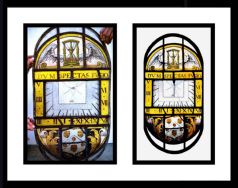 |
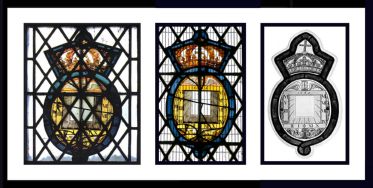 |
 |
| Maker: John Oliver (1616-1701) Date: 1669 Original Location: the Hall of the Worshipful Company of Weavers, London, England Present Location: moved to the Weavers' Company almshouses, New Wanstead, London (Weavers' House, 78-82A, rear window of new annex) Orientation: Vertical. Declines 15° east of south. Size: 83.3 x 43.5 cm (32.8 x 17.1 in) Adornment: Wings with hourglass, heraldic shield, spider on web attacks fly. Mottos: “Dum Spectas Fugio” (I fly while you watch) Condition: good, restored. Comments: In 1916 window was removed and stored for safekeeping during Zeppelin bombing raids on London. It was then lost in storage in the Company's New Wanstead premises. Thanks to the detailed inventories of The Royal Commission on Historical Monuments, a search found this valuable dial shortly prior to its restoration in 1988. It was cleaned and restored with a new brass gnomon, fitted to a brass frame, and set up in the new extension of the Weavers House, at New Wanstead, in a window that had been specially constructed to allow for the sundial's original declination. Restored by Plowden & Smith, 1988 Article by Geoffrey Lane (6 MB): (2006) Glass Sundial Makers of 17th Century London. "The British Sundial Society Bulletin" Vol. 18(i), March 2006. 40-47 Article by Christopher Daniel (5 MB): (Apr 1988) Stained Glass Sundials in England and Wales. "Clocks" 10, 30-37 Building Conservation Website: Here Worshipful Company of Weavers Website: Here Photo Descriptions: Photo ‘a’ is courtesy of Christopher Daniel © C StJ H D and shows dial without gnomon before restoration. Photo ‘b’ and ‘c’ are courtesy of Tony Moss. Photo ‘b’ shows dial with gnomon after restoration (Shadow says it's 10:15 am). I can’t remember the source of the other photos that show the dial reinstalled at Weavers’ House. Photo ‘g’ shows the information plaque at Weavers’ House. Photos: a b c d e f g h |
Maker: prob. John Oliver (1616-1701) Date: 1664 Original Location: South wall of Widdington Church, Essex England Present Location: The dial has been re-mounted in a north window of Widdington Church which has a protective grill outside. Orientation: originally for a vertical south wall Size: 46 x 23 cm (18.1 x 9 in) Adornment: crown, hourglass & wings Mottos: none Condition: cracked, re-leaded, gnomon missing Comments: The church guide says- "SUNDIAL with hourglass and crown, dated 1664. Originally in one of the south windows and placed here in 1874. This window may be earlier than 12th century." Since we are certain that this window is not from the 12th century, Mike Cowham rightly says- "I am not sure what part of the window is supposed to be 12th century unless it is the stone frame!" We are looking for a color copy of Eden's drawing. Article by Geoffrey Lane (6 MB): (2006) Glass Sundial Makers of 17th Century London. "The British Sundial Society Bulletin" Vol. 18(i), March 2006. 40-47 Article by Christopher Daniel (5 MB): (Apr 1988) Stained Glass Sundials in England and Wales. "Clocks" 10, 30-37 Photo Descriptions: Photo ‘a’ is courtesy of Christopher Daniel © C StJ H D and shows actual sundial at original location. Photo ‘b’ is courtesy of Mike Cowham, taken Jan 2005 and shows remounted sundial at new location with grill. Photo ‘c’ is a photocopy of drawing by F. Sydney Eden that is probably of a reproduction. Original color drawing is at the Victoria & Albert Museum, London England (Catalog # E297-1922). Photos ‘d’ and ‘e’ are by John Carmichael. Photos: a b c d e |
Maker: John Oliver (1616-1701) Date: 1600's Original Location: Originally was in the Presence Chamber of Lambeth Palace, London, England. Present Location: Was moved to a window in Lollard's Tower of Lambeth Palace, London, England. It's unknown if it's still there. Orientation: Vertical. Declines south Size: unknown Adornment: a fly Mottos: none Condition: unknown Comments: drawing by F. Sydney Eden. Original color drawing of sundial is in the print Room Collection at the Victoria & Albert Museum, London England (Catalog # E956-1926). We are looking for more information and better photos of this dial or a color copy of Eden's drawing. Article by Geoffrey Lane (6 MB): (2006) Glass Sundial Makers of 17th Century London. "The British Sundial Society Bulletin" Vol. 18(i), March 2006. 40-47 Lambeth Palace Library Website: Here Photo Descriptions: Photo is from unknown source. Photos: a |
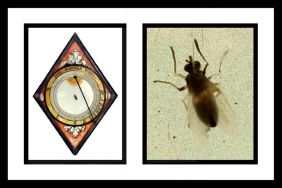 |
 |
 |
| Maker: John Oliver (1616-1701) Date: 1664 Original Location: The Northill Rectory in Northill, Bedfordshire England. Lat: 52.1° N. Lon: 0.3228° W Present Location: At original location Orientation: Vertical. Declines towards the east Size: 25.4 cm (10 in) Adornment: Design mimics the other Northill dial (Dial 103). Has a housefly, a sun at the dial hourline center and ornamental flowing scrolls. Hours are in Roman numerals. Mottos: “Dum Spectas Fugio” (I Fly While You Watch) Condition: cracked. Dial was restored in 1992 at Chapel Studio by Alfred Fisher. Comments: Gnomon with stay has been incorrectly reinstalled on the inside of the panel. Gnomon stay at 10:00 am mark. The roman numerals for 9 (IX) and 11 (XI) are incorrectly painted as 9 (XI) and 11 (IX). This is one of a pair of newly discovered John Oliver dials located at the church. This dial is protected inside for safe keeping. Viewing by appointment only. References: Gatty, Mrs Alfred, Eden and Lloyd, The Book of Sun-Dials, 3rd edition, 1890, pp 93-94. Britton, John, and Brayley, Edward Wedlake- The Beauties of England and Wales; or Delineations of Each County. Vol. I. Beds, Berks, Bucks, London 1801 Article by Geoffrey Lane (6 MB): (2006) Glass Sundial Makers of 17th Century London. "The British Sundial Society Bulletin" Vol. 18(i), March 2006. 40-47 Worshipful Company of Glaziers Website: Here Photo Descriptions: Photos are courtesy of Mike Cowham. Photos: a b |
Maker: John Oliver (1616-1701) Date: 1664 Original Location: The Northill Rectory in Northill, Bedfordshire England. Lat: 52.1° N. Lon: 0.3228° W Present Location: At original location Orientation: Vertical. Declines towards the east. Size: 25.4 cm (10 in) Adornment: Design mimics the other Northill dial (Dial 96). Has a fruitfly, 2 cherry fruits with leaves, ornamental flowing scrolls. Hours are in Arabic numerals. Mottos: “Sic Transit Gloria Mundi” (Thus Passes the Glory of the World) Condition: cracked, gnomon is missing. Was restored in 1992 at Chapel Studio by Alfred Fisher. Comments: Gnomon hole visible. This is one of a pair of newly discovered John Oliver dials located at the church. This dial is protected inside for safe keeping. Viewing by appointment only. Article by Geoffrey Lane (6 MB): (2006) Glass Sundial Makers of 17th Century London. "The British Sundial Society Bulletin" Vol. 18(i), March 2006. 40-47 References: Gatty, Mrs Alfred, Eden and Lloyd, The Book of Sun-Dials, 3rd edition, 1890, pp 93-94. Britton, John, and Brayley, Edward Wedlake- The Beauties of England and Wales; or Delineations of Each County. Vol. I. Beds, Berks, Bucks, London 1801 Worshipful Company of Glaziers Website: Here Photo Descriptions: Photos are courtesy of Mike Cowham. Photos: a b |
Maker: John Oliver (1616-1701) Date: 1648 Original Location: unknown location in England Present Location: In a south window of the Directors office at The Museum of The History of Science, Oxford, Oxfordshire England Orientation: Vertical. Declines east. Size: height-14.3 cm (5.6 in) Adornment: a fly Mottos: none Condition: fair. Gnomon is missing. Comments: came from the Lewis Evans Collection. It's Interesting that hours 4 to 9 are Arabic numerals, but X and XI are in Roman numerals. Viewing by permission only. We need a better photo. Article by Christopher Daniel (2 MB): (1987) Shedding a Glorious Light. "Country Life" 181, 72-75 Museum of The History of Science, Oxford Website: Here Photo Descriptions: Photos ‘a’, ‘b’, ‘c’ are from unknown sources. Photo ‘d’ is from Hans Behrendt videotape. Photos: a b c d |
 |
 |
 |
| Maker: John Oliver (1616-1701) Date: 1665 Original Location: somewhere in England Present Location: unknown. Last seen in the Wilfred Drake collection Orientation: Vertical. Declination is undetermined. Size: unknown Adornment: a fly Mottos: “Dum Spectas Fugio, Mors Venit” (I fly while you watch, death comes) Condition: unknown. Gnomon is missing. Comments: drawing by F. Sydney Eden. We are looking for more information and better photos of this dial. Photo Descriptions: Photo is from unknown source. Photos: a |
Maker: possibly John Oliver Date: probably 1600's Original Location: Provenance of dial unknown but believed to have been part of the glass collection of Sir George Osborne, an early 19thC antiquary. Ref- Marcus Binney, Country Times & Landscape, November 1988, p77 Present Location: It's set in the left-hand (as viewed from inside) of a trio of stained glass panels, which are approx a yard tall by 10" wide, and fitted in a small SE facing oriel window at the Defense Intelligence and Security Centre, Chicksands Priory in Bedford, Bedfordshire England. Latitude and longitude are undetermined. Orientation: Vertical. Declines east. Size: width- 12.7 cm (5 in) Adornment: Fly motif in centre. Shows 4am to 2pm in half hours. Uses IIII and cross pattee for Noon. Sun's rays stream from gnomon aperture. Mottos: "Hinc Humana Leguntur Tempora" (From Here, Man Reads the Hours) Condition: Good, but gnomon is missing and glass has a re-leaded crack. The BSS Sundial Register says dial is upside down, but it was not upside down when Peter Tandy saw it in Oct. 2004. No sign of restoration. Comments: One of the most realistic fly paintings on glass with body and wings on opposite sides of the glass. Dial was also mentioned in videotape movie and transcript by Hans Behrendt called "Alte Englischen Fenstersonnenhren" 1990. Restricted viewing available in tour conducted by the Friends of Chicksands Priory. No photography allowed. Article by Geoffrey Lane (6 MB): (2006) Glass Sundial Makers of 17th Century London. "The British Sundial Society Bulletin" Vol. 18(i), March 2006. 40-47 Videotape Transcript of Dial 154 only: Here Videoranch Photos Website: Here Chicksands Priory Website: Here Photo Descriptions: Photos are courtesy of Mike Cowham taken Jan. 2005. Photos: a b c d e f g |
Maker: Has all the characteristics of a John Oliver Dial. Date: 1670 Original Location: Groombridge Place, East Sussex, England Present Location: at original location Orientation: Vertical. Declines south. Size: unknown Adornment: sun & fly Mottos: “Lumen Umbra Dei” (trans- Light (is) the shadow of God) Condition: good, but is missing the gnomon Comments: One of a pair of sundials in master bedroom. Mr. Packer built house designed by Wren in reign of Charles II. We need more photos of this dial. Article by Geoffrey Lane (6 MB): (2006) Glass Sundial Makers of 17th Century London. "The British Sundial Society Bulletin" Vol. 18(i), March 2006. 40-47 Article by Christopher Daniel (5 MB): (Apr 1988) Stained Glass Sundials in England and Wales. "Clocks" 10, 30-37 Groombridge Place Website: Here Photo Descriptions: Photo is courtesy of Christopher Daniel © C StJ H D. Photos: a |
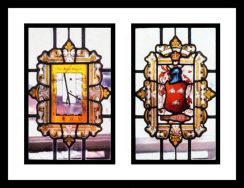 |
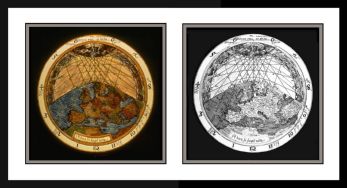 |
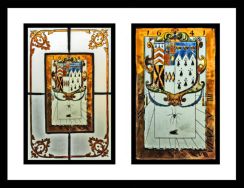 |
| Maker: unsigned but attributed to John Oliver (1616-1701) Date: supposedly about 1672 Original Location: in home of Alexander Robertson, 12th Chief of Clan Robertson in Dunalastair Scotland, about 33 miles northwest of Perth. Present Location: rescued from fire at Dunalastair in 1745. Its current whereabouts is unknown. It is lost or hidden at an unknown location. Orientation: Vertical. Declines 18° 50’ east of south. Size: unknown Adornment: a daddy long legs and a fly (quite similar to those on the Weavers Company Dial by John Oliver) Mottos: none on sundial. On heraldic shield- “Virtutis Gloria Merces” (Glory is the Reward of Valour) Condition: unknown Comments: we are looking for more information and better photos of this dial. This Information is from the Mr. Daniel’s article below. Article by Christopher Daniel: (Dec 2004) McGregor's Leap. The Sundial Page, "Clocks" Vol. unknown Wikipedia Website: Here Photo Descriptions: Photos are courtesy of Christopher Daniel © C StJ H D and are photocopied and photoshopped from his article, “Mcgregor’s Leap” (see link above). It is unknown from where Mr. Daniel obtained these photographs. Left photo above shows sundial, right photo shows the Heraldic Arms of Robertson of Struan. Photos: a b |
Maker: by artist Josias Murer of Oberwinterthur Switzerland from brother Johann Murer's (1556-1641) instructions. Date: 1620 or 1630 according to Monika Leonhardt, M.A. at Uhrenmuseum Beyer (Beyer Clock Museum) in Zurich. Original Location: lat: 47º 33' N, Lon: 7º 35' E. We previously thought that its original location was in a leaded window at the Federal Astronomical Observatory of Zurich in Switzerland. In 2008, Mrs. Sigrid Pallmert SLM, curator of the Swiss National Museum in Zürich, told us in 2008 that its original location was at “Eidgenössische Sternwarte Zürich” (Semper Sternwarte, near the Swiss Federal Institute of Technology). Present Location: In July 2008, with the help of Monika Leonhardt and Sigrid Pallmert, we found out that the sundial now is in the depository of the Swiss National Museum in Affoltern am Albis. Sadly, it is not on display. Orientation: Vertical. Declines south. Size: Hans Behrendt said that it measures 30 cm (11.8 in) in diameter, but Sigrid Pallmert says that it measures 27.5 cm (10.82 in). Adornment: map of Europe, zodiacal signs. Mottos: ‘Vt hora Sic uita fugit’. In Latin only one letter is used for “U” and “V”. So You have to read UT HORA SIC VITA FUGIT: (trans. ALIKE THE HOUR LIFE FLIES) Inscriptions: At the top it says- "Johan Murer Pfarrer zu Rickenb." ("Johan Murer rector at Rickenbach"). Condition: A photograph of it sent to us in July 2008 shows it to be in excellent condition. But the gnomon might be missing. Comments: Dial has four time systems. Indicates where in the world it is noon. Several reproductions exist. Article by Hans Behrendt (in German): Here Behrendt VHS Transcript (in German): Here Swiss Museum Website: Here Monika Leohardt’s Email: Here Sigrid Pallmert’s Email: Here Andrea Kunz’s Email: Here Photo Descriptions: Copying and reproduction of photos ‘a’ and ‘b’ is strictly prohibited without written permission from Swiss National Museum. John Carmichael has signed a permission form with the museum which allows us to publish the photo here. Contact Andrea Kunz at the museum for permission. Other photos may be used without permission. Photo ‘a’ is the best known photo of the actual sundial that is owned by the Swiss National Museum in Zurich. In July 2008, Monika Leonhardt sent it to John Carmichael. She obtained the photo from Sigrid Pallmert. John has asked Mrs. Pallmert and Andrea Kunz, lic. phil to send him a better high resolution photo. Photo a’s negative number at the museum is- COL-0638. Photo ‘b’ is a cropped copy of photo ‘a’. Photo ‘c’ is copied from Hans Behrendt’s videotape and probably shows the actual sundial mounted in a leaded window at its original location. Photos ‘d’ and ‘e’ are window hanging modern reproductions. Photo ‘f’ is a still frame copy from Hans Behrendt’s videotape showing a table-top reproduction. Photo ‘g’ is an excellent black and white drawing of the original sundial by an unknown artist. Photos: a b c d e f g |
Maker: Baptista Sutton (1600-1667) Date: 1641 Original Location: Commissioned by a Puritan Essex MP, Sir Thomas Barrington for his leased home on Great Queen Street in London England, near Sutton’s shop. It wound up at Warneford Place in a hamlet called Sevenhampton about 1 mile south of Highworth, Wiltshire England. This was formerly the home of Lord Banbury until it was sold to Ian Fleming (of James Bond fame) in 1960. The window survived in Warneford Place until 1960, and was presumed lost until Jo Clark rediscovered it in May 2007. It’s unknown if the dial was removed before the property was sold to Lord Banbury. Present Location: Jo Clark confirmed in May 2007 that it is not in the remodeled Warneford Place and found out that it now hangs in a wooden frame on a wall in a new owner’s home in London England. The owner wishes to remain anonymous. Orientation: Vertical. Declines about 41° east of south. Size: Entire Window- 46 x 28.8 cm. (18 x 11.3 in); Dial Only (to outside of surrounding came)- 27.8 x 17.3 cm (11 x 6.8 in) Adornment: Barrington coat of arms and a spider hanging from a single-strand web above a fly. First example of a stained glass sundial that uses Roman numeral "IIII" for 4 o'clock and a cross pattee for noon. Inscriptions: “1641” at top. John Davis says: “Most interestingly, on the back (outside) of the dial, the number "42" is scratched into the glass near the centre-top, behind the crest on the coat of arms. Is this Sutton's 42nd dial? - the 42nd panel in a larger scheme?” Condition: John Davis reported in Nov 2007 that it was “generally in good condition but with a number of hairline cracks and some very small losses of paint. There are a total of four gnomon holes- of the lower three, two are now filled.” Comments: According to the Sevenhampton website, Ian Fleming moved into Warneford Place with his wife, Ann, when building on the new Sevenhampton Place was completed three years later. Ann remodeled it, so much so, that Evelyn Waugh commented that “She had changed a mansion into a cottage”. Jo Clark reports that it seems Ian Fleming actually loathed the reconstructed Warneford Place. Ian Fleming died in 1964. This important historical dial was rediscovered thanks to the detective work of Ms. Jo Clark who saw the old photos of the dial in this website and became curious to find it. All the dial information here was obtained from Hans Behrendt, Geoffrey Lane, Jo Clark and John Davis. Article by Geoffrey Lane (6 MB): Glass Sundial Makers of 17th Century London. "The British Sundial Society Bulletin" Vol. 18(iv), March 2006. pg. 40-47 Article by John Davis (1MB): The ‘Lost’ Barrington Stained Glass Dial Rediscovered. "The British Sundial Society Bulletin" Vol. 21(ii), June 2009. Pg. 12 Videotape Transcript of Dial 149 only: Here Highworth Wiltshire Website: Here Sevenhampton Website: Here Jo Clark’s Email: Here Geoffrey Lane’s Email: Here John Davis’s Email: Here Photo Descriptions: Carmichael scanned Photo 149a from an article by Hans Behrendt called "Alte Englischen Fenstersonnenhren" 1984. Photo 149b was taken by P.S. Spokes in 1945 and Geoffrey Lane used it with the permission of Mrs. A Spokes Symond in his article in the BSS Bulletin (see link below). After being rediscovered, John Davis took photos 149c and 149d in Nov. 2007, and we use them with his permission. Photo ‘e’ is a map of Southhampton. Photos: a b c d e f |
 |
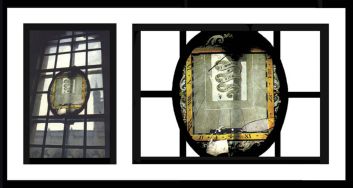 |
 |
| Maker: unknown Date: 1600's Original Location: Adstone Farmhouse in Towcester, Northhamptonshire England Present Location: Set in farmhouse stairway window; formerly in master bedroom. Orientation: Vertical. Declines east. Size: small Adornment: none Mottos: none Condition: cracked Comments: We are seeking better photographs of this dial. Article by Christopher Daniel (5 MB): (Apr 1988) Stained Glass Sundials in England and Wales. "Clocks" 10, 30-37 Tour UK Website: Here Photo Descriptions: Photo is courtesy of Christopher Daniel © C StJ H D. Photos: a |
Maker: unknown Date: unknown Original Location: Winchester College, Hampshire, England Present Location: at original location Orientation: Vertical. Declination is unknown. Size: unknown Adornment: fly in lower right corner Mottos: Motto on a scroll at the top says- “Ut Umbra, Sic Vita Transit” (As a shadow so doth life pass.) Condition: Sadly damaged. We need updated information and better photos of this dial. Comments: We need updated information and better photos of this dial. Article by Christopher Daniel (5 MB): (Apr 1988) Stained Glass Sundials in England and Wales. "Clocks" 10, 30-37 Photo Descriptions: Photos ‘a’ and ‘b’ are courtesy of Christopher Daniel © C StJ H D. But they are poor copies of copies. Photo ‘b’ is a photoshopped copy of ‘a’. Photo ‘c’ is a notebook sketch by unknown artist from an unknown source. Photos: a b c |
Maker: unknown Date: probably 1600's Original Location: unknown place in England Present Location: unknown. Last known to be in the Dr. William Cole collection Orientation: Vertical. Declines northwest. Size: unknown Adornment: a fly Mottos: "carpe, praeterit" (translation unknown) Inscription: undetermined Condition: unknown Comments: We need more information and better photos of this lost dial and an English translation of the videotape transcript. Article by Geoffrey Lane (6 MB): (2006) Glass Sundial Makers of 17th Century London. "The British Sundial Society Bulletin" Vol. 18(i), March 2006. 40-47 Videotape Transcript of Dial 152 only: Here Photo Descriptions: This poor quality photo and information are copied from a videotape movie and transcript by Hans Behrendt called "Alte Englischen Fenstersonnenhren" 1990 Photos: a |
 |
 |
 |
| Designer & Maker: unknown Date: unknown, probably 1600's. Original Location: St. Mary Magdalene Church, Newark, Nottinghamshire, England Present Location: at original location Orientation: Vertical. The dial depicted is a due south wall dial. Size: unknown Adornment: highly ornamented Mottos: undetermined Condition: Excellent Comments: This is not an actual working stained glass dial, but is a painting on stained glass of a vertical wall dial with its painted gnomon, held in the hands of two people. Ian Butson suggests that the time of '3 hours', as indicated by the painted shadow on the dial, is significant in Biblical terms as the hour of the death of Jesus. We are looking for better photos of the entire window and close-ups of the sundial depiction. Church of England Website: Here Photo Descriptions: Photos are from unknown sources. Photos: a b |
Maker: unknown Date: 1648 Original Location: Norwich England Present Location: Moved to a south window of the Director's office at The Museum of The History of Science, Oxford, Oxfordshire England Orientation: Vertical. Declines about 15° East of South Size: Dial Face is about 14 cm (5.5 in) high. Original oval panel at Norwich measured 27.5 x 21 cm (10.8 x 8.3 in) Adornment: a sun around gnomon hole. It is odd that when the dial was at Norwich, German words appear in the oval surrounding the dial. We have not been able to translate these words. Behrendt said this: "This black-and-white picture has long posed a riddle. The south-east dial face is surrounded with a compound inscription, possibly taken from a 'Kreisring' [annulus]. The text cannot be deciphered. Mottos: “Dum Spectas Fugio” (I Fly While You Watch) Condition: fair. Gnomon is now missing. Comments: Was a gift to the museum from Dennis King of Norwich, the glazier who installed the window at the Museum in 1956. Viewing is by permission only. Museum of The History of Science, Oxford Website: Here Photo Descriptions: Photo ‘a’ shows original installation in Norwich. This poor quality photo and some of this information are copied from an article by Hans Behrendt called "Alte Englischen Fenstersonnenhren (II)" 1990. Photo ‘b’ shows current installation at the museum. Photo ‘c’ is from the Hans Behrendt videotape. Photos: a b c |
Maker: Reverand Francis Hall (alias Line), Professor of Mathematics at Liege University for His Majesty. Date: 1669 Original Location: In his Majesty's (King Charles II) Privy Garden at Whitehall, London England. Whitehall was the King's primary residence in London before it was destroyed by fire. Present Location: unknown. Lost and probably destroyed Orientation: Declination undetermined, but some are inclined to vertical. Size: unknown Adornment: many painted glass sundials Mottos: unknown Condition: Some researchers say the dial was quickly destroyed by weather and vandals. Others are certain that The Earl of Rochester destroyed it on the night of 25 June 1675, because in Stephen Jefferys' play, "The Libertine", there is a scene featuring his destruction of the dial. Comments: Famous "pyramidical" sundial. The dial was like a huge candelabra of panels glass spheres floating freely in fluid inside larger glass spheres. it was considered one of the greatest, or at least the most expensive, scientific instruments in Europe. According to C. Daniel, it was made of stone, iron, brass, wood and glass with about 270 individual component dials including a number of spherical glass dials and painted plane glass dials. Carefully recorded details in an 'Explication' published in London in 1673. Article by Christopher Daniel (5 MB): (Apr 1988) Stained Glass Sundials in England and Wales. "Clocks" 10, 30-37 Letter from Fred Sawyer: Here Francis Line Website: Here Photo Descriptions: Photo is courtesy of Christopher Daniel © C StJ H D Photos: a |
 |
 |
 |
| Maker: Henry Gyles of York(1645-1709) Date: 1687 Original Location: In a stairwell of University College, Oxford England Present Location: at original location Orientation: Vertical. Declines south. Size: 30 x 15 cm (11.8 x 5.9 in) Adornment: Figure of Christ holding and orb with his left hand. Mottos: "SUM VERA LUX" ("I am the True Light") Condition: cracked, but otherwise in good condition. Was re-leaded at unknown date. Gnomon is missing. Comments: The late English sundial historian, Margaret Stanier said in her booklet, “Oxford Sundials” (2003): “Gyles gave it to the college gratis on completing a large order for the east window of the Chapel. This is not the chapel’s present east window, but several plans of Gyles’ east window still exist elsewhere in the College.” She said that the dial would probably function if supplied with a new gnomon. Viewing is by permission only. We need updated information and more photos of this dial (interior and exterior). Please help! Article by Geoffrey Lane (6 MB): (2006) Glass Sundial Makers of 17th Century London. "The British Sundial Society Bulletin" Vol. 18(i), March 2006. 40-47 Article by Christopher Daniel (5 MB): (Apr 1988) Stained Glass Sundials in England and Wales. "Clocks" 10, 30-37 Page from "Stained Glass" by Lawrence Lee, George Seddon & Francis Stephens: Here University College Oxford Website: Here Photo Descriptions: Photo ‘a’ is courtesy of Christopher Daniel © C StJ H D. Photo ‘b’ is a page from "Stained Glass" by Lawrence Lee, George Seddon & Francis Stephens. Photos: a b |
Maker: Henry Gyles (1645-1709) Date: 1670 Original Location: Nun Appleton Hall, York, England. Present Location: It was removed from the Nun Appleton vestibule at an unknown date and wound up for display at the entrance to York Art Gallery. It was placed in a dark corner where it was back-lit with an electric light box. Andrew James reported in 2008 that it was removed for storage and safekeeping. He thinks that it might be possible to arrange for private viewings at The York Art Gallery. Orientation: Vertical. Declines south. Size: unknown (large) Adornment: Cupid holds a small sundial. Small landscapes with The Four Seasons. House was rebuilt by Sir William Milner whose arms are on a corresponding pane of glass. Mottos: “Qui non est Hodie” (Who is not today). Lines from Ovid- “Poma dat Autumnus, Formosa est messibus Aestas, Ver praebet fores, Igne levatur hiems”. (Autumn gives fruits, Summer fair with corn appears, Spring bestows flowers, Winter fire cheers). Condition: excellent despite its age Comments: Designed from a print by Titian. We need updated information and better photos of this dial. Article by Christopher Daniel (5 MB): (Apr 1988) Stained Glass Sundials in England and Wales. "Clocks" 10, 30-37 Article by Christopher Daniel (2 MB): (1987) Shedding a Glorious Light. "Country Life" 181, 72-75 York Art Gallery Website: Here The Book of Sundials by Gatty: Here Photo Descriptions: Photo ‘a’ is from unknown source and shows dial mounted on lightbox at the art gallery. Photo ‘b’ shows dial above entrance door at its original location. This poor quality photo and some of this information are copied from an article by Hans Behrendt called "Alte Englischen Fenstersonnenhren (II)" 1990. Photo ‘c’ is a photocopy of a drawing by Gatty from "The Book of Sun-Dials". Photos: a b c |
Maker: despite the design's simplicity, Chris Daniel believes it to be by Henry Gyles (1645 -1709) Date: 1672 Original Location: In south facing room called the Cedar Closet at Tredegar House, in Gwent, Newport, Wales UK Present Location: at original location Orientation: Vertical. Declines south. Size: 27.9 x 25.4 cm (11 x 10 in) Adornment: a house fly in lower right and another fainter fly in the center. Mottos: “Lumen Umbra Dei” (Light is the Shadow of God) Condition: poor, cracked and re-leaded Comments: Only known Welsh glass sundial. Reference- C. St.J. H. (1995) The Stained-Glass Sundial at Tredegar House. "Clockwise Around Wales" Edited by Paul Parker, Vale Books Article by Geoffrey Lane (6 MB): (2006) Glass Sundial Makers of 17th Century London. "The British Sundial Society Bulletin" Vol. 18(i), March 2006. 40-47 Article by Christopher Daniel: (1995) Stained Glass Sundials at Greys Hall and Tredegar House. "Clockwise Around Wales" Article by Christopher Daniel (5 MB): (Apr 1988) Stained Glass Sundials in England and Wales. "Clocks" 10, 30-37 Tredegar House Website: Here Wikipedia Website: Here Photo Descriptions: Photos are courtesy of Christopher Daniel © C StJ H D. But they are poor copies of copies. We need updated information and better photos of this dial. Photos: a b |
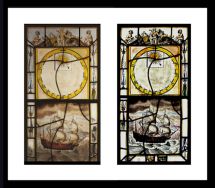 |
 |
 |
| Maker: unknown, possibly by Henry Gyles (1645-1709) Date: 2nd half of the 1600's Original Location: Lullingstone Castle, Kent, England Present Location: south side of St. Botolph's Church, Lullingstone, Kent, England Orientation: declines about 15º west of south Size: 60 x 30 cm (24 x 12 in) Adornment: A very realistic fly with wings and body is on different sides of the glass. There is a sun face and Father Time with a scythe and an hour glass. At top corners two putti are holding festoons of ribbon. Below the dial is a square panel with painting in enamel of a four-masted ship in full sail having two tiers of guns, in a stormy sea (Trevor Brighton says this signifies the passing of time). Some initials (might be “R W J 22-om”) were scratched on the external surface above the 'noon' symbol. Mottos: Immediately below the dial, almost hidden by an iron saddlebar, is “ASPICE ME VT ASPICIAR” (look at me and I am looked at) Condition: good, cracked glass surrounds 5 mm gnomon hole. Gnomon is missing. Three other holes (3 mm dia.), probably for support stays, have been drilled in the outer glass perimeter if the dial, between I and III. Window was restored twice. Comments: It’s a fine circular dial with broken pediment. Dial panel is the center panel of a three-paneled window in the nave. Has flat lead came (6 and 8 mm) in good condition, but unfortunately it’s not original. Second restoration was by Keith & Judy Hill. Article by Christopher Daniel (2 MB): (1987) Shedding a Glorious Light. "Country Life" 181, 72-75 Glass Conservation Website: Here St. Botolphs Website: Here Farningham & Eynsford Website: Here Flickr Website: Here Photo Descriptions: Photo ‘a’ is courtesy of Christopher Daniel © C StJ H D and shows dial after 1st restoration in the 1930's. Photo ‘b’ is courtesy of Keith & Judy Hill and shows recent restoration. Photos ‘c’ is from unknown source. Photo ‘d’ is courtesy of Mark Ynys-Mon from Flickr website above. Photos: a b c d |
Maker: attributed to Henry Gyles (J.T.Brighton, 'Henry Gyles, Virtuoso and Glasspainter of York 1645 -1709'). Date: unknown. Probably 1600's Original Location: unknown location in England. J.Trevor Brighton suggests that Gray's Court is not its original location and that it was designed for someplace else. Present Location: Gray's Court at The University College of Ripon and York St John, York England (formerly St John's College). Orientation: Vertical. Declination is undetermined. Size: small Adornment: flower Mottos: “Ita Vita” (Thus Passes Life) Condition: cracked. The gnomon is missing. Comments: Viewing by permission only. Article by Geoffrey Lane (6 MB): (2006) Glass Sundial Makers of 17th Century London. "The British Sundial Society Bulletin" Vol. 18(i), March 2006. 40-47 Article by Christopher Daniel: (2004) “Sundials” a Shire Book Article by Christopher Daniel: (1995) Stained Glass Sundials at Greys Hall and Tredegar House. "Clockwise Around Wales" Article by Christopher Daniel (2 MB): (1987) Shedding a Glorious Light. "Country Life" 181, 72-75 University College Of Ripon And York St John Website: Here Photo Descriptions: Photo ‘a’ is courtesy of Tony Moss and taken by him. Photo ‘b’ is by John Carmichael and taken by him in 2004. Photo ‘c’ is courtesy of Christopher Daniel © C StJ H D and is copied from one of his articles. Photos: a b c |
Maker: glass painter, Baptista Sutton (1600-1667) Date: 1627 Original Location: was probably installed in the large south-facing bay window near the high table in The Great Hall of the Middle Temple in London, where, according to Geoffrey Lane, "the resident judges and their guests could learn to appreciate its usefulness in setting their watches". Present Location: Middle Temple Hall, east window. London England Orientation: originally faced south. Size: unknown Adornment: coat of arms Mottos: none Inscriptions: Main inscription at bottom says: "Nicholas Hyde Miles Capitalis justiciarius ad Placita Corani Riege Carolo 1626". The date and Sutton's latinized signature "Baptista Sutton" appear on either side of the main inscription. Condition: cracked and re-leaded. Unknown if gnomon still exists Comments: Commemorates Sir Nicolas Hyde, the new Chief Justice of the Common Pleas. Recently re-discovered by stained glass historian, Brian Sprakes. Article by Geoffrey Lane (6 MB): (2006) Glass Sundial Makers of 17th Century London. "The British Sundial Society Bulletin" Vol. 18(i), March 2006. 40-47 Photo Descriptions: Photo is courtesy of and © Geoffrey Lane. Photos: a |
 |
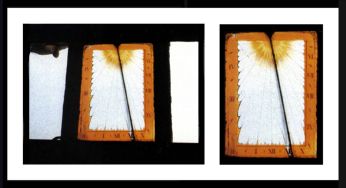 |
|
| Maker: unknown Date: 1600's Original Location: High up on south wall of Litchborough Church, Northhamptonshire, England Present Location: at original location Orientation: Vertical. Declines south. Size: height and width of inner triangle- 30.5 x 24 cm (12 x 9.5 in) Adornment: a yellow sun Mottos: none Condition: cracked, gnomon is missing Comments: This window has been restored twice since it was cracked. Older photo on left (circa 1988) shows lead came added to repair cracks in the first restoration. Newer second photo (2003) shows innovative second 1998 restoration with repair came removed, exposing the old cracks again. Epoxy resin now joins the broken glass that's sandwiched between two protective clear panes of glass for support and protection. Third photo shows outside view. Fourth photo shows two holes for gnomon stays in the 12 o'clock line area. Second restoration was by Barley Studios of Church Balk, Dunnington. Article by Christopher Daniel (5 MB): (Apr 1988) Stained Glass Sundials in England and Wales. "Clocks" 10, 30-37 Church of England Website: Here Photo Descriptions: Photo ‘a’ is courtesy of Christopher Daniel © C StJ H D, Other photos are courtesy of Colin Davis and Mike Cowham. Photos: a b c d e f g h i j |
Maker: unknown. Roger Bowling speculates that John Byron could have instigated it. (See his article below) Date: unknown Original Location: According to Roger Bowling, it was situated in a large eight-light bow window in Kersal Cell, near Manchester, England Present Location: at original location Orientation: Vertical. Declines southeast. Size: unknown Adornment: Roger Bowling notes that it is a simple design with a sun that shines through white clouds with scalloped edges. He says that “it doesn’t match the style of any of the known makers of stained glass dials, but appears to be in a typical early 18th century style.” He notes that Mottos: none Condition: good, gnomon attached Comments: shadow says it's ten fifty am. We need updated information and better photos of this dial. Article by Christopher Daniel (1 MB): (Jun 2007) The Kersal Cell. The Sundial Page, "Clocks" Vol. unknown Article by Christopher Daniel (5 MB): (Apr 1988) Stained Glass Sundials in England and Wales. "Clocks" 10, 30-37 Article by Roger Bowling: (Sep 2009) Two Manchester Glass Dials "The British Sundial Society Bulletin" Vol. 21(iii), pgs. 32-33 Wikipedia Website: Here Photo Descriptions: Photos are courtesy of Christopher Daniel © C StJ H D. Photos: a b |
 |
 |
 |
| Designer & Maker: unknown Date: unknown, probably 1600's. Original Location: Lat: 51° 39.3' N; Lon: 2° 11.0' W. About 15 feet high (4.5 meters) in the centre top panel of a nine panel leaded window in the Great Hall at Chavenage House near Tetbury, Gloucestershire England. Present Location: at original location Orientation: Vertical. Declination unknown exactly, but declines to the east of south. Size: about 15.2 x 25 cm (6 x 10 in) Adornment: a sun on dial face. Surrounding window elaborately decorated. Mottos: none Condition: Crack originates from gnomon hole, crack was re-leaded. Gnomon is missing. Comments: No gnomon exists but the three holes at the bottom of dial face indicate a triple support stay was used. Dial shows hours and half hours. We are anxiously looking for more information and better photos of this dial and its surrounding window. Reference: The "Stained Glass at Chavenage House", Dr Hilary Wayment F.S.A. Antiquaries Journal - 'Tetbury' Vol. 78 1998 Chavenage Website: Here Photo Descriptions: Photos are all from unknown sources. Photo ‘d’ is of the Great Hall. Photos: a b c d |
Maker: unknown Date: probably 1600's Original Location: Dial 74- unknown location in England. Possibly the Convocation House at the Bodleian Library in Oxford England. Dial 75- The Convocation House's west window. Present Location: Dial 74- now in the Convocation House's high south window above the Vice-Chancellor's Chair, at the Bodleian Library in Oxford England. It is possible that dial was moved to this location after 1923. Dial 75- now on south wall of Convocation House. Orientation: Dial 74- declines south, Dial 75- declines west of south. Size: both are small dials. estimate- Dial 74- 38 x 30 cm (14.9 x 11.8 in) Adornment: Dial 74- blue rectangle with half sun and dragonfly on dull white background, on gold with some Roman numerals visible. Possibility of another fly on main background. Dial 75- yellow brimstone butterfly and spray of roses. Mottos: none Condition: Dial 74- poor, most numerals worn off, cracked. Dial 75- very poor, very worn. Comments: Neither has its gnomon now. View with binoculars. We are looking for better photographs of both these dials. Bodleian Library Website: Here Photo Descriptions: Photo ‘a’ is courtesy of the late Margaret Stanier and was photocopied from her booklet- ‘Oxford Sundials’. We miss you Margaret! Photo ‘b’ is a photograph from Hans Behrendt’s videotape. Photos: Dial 74: a b Photos: Dial 75: a b |
Delineator: unknown, possibly Henry Gyles Glass Artist: unknown (Looks very much like a Henry Gyles Dial) Date: unknown. Probably around 1675 Original Location: In a south facing window at the Tyttenhanger House, in St Albans, Hertfordshire England. (now used as commercial offices.) Present Location: still at the Tyttenhanger House, but is now in a north facing room hanging in front of a window. Patrick Powers says: “The dial itself is set as a centrepiece in some more flowery (and inappropriate) glass in a separate frame which is fixed, not just hung, on the inside of a Georgian window frame. The wooden bars of the Georgian window therefore obstruct the clear view through the dial. That dial frame is mounted (backwards) in such a way that the dial appears the wrong way round to anyone inside the chapel of the house (which is where the dial is) - I expect whoever set it there wanted the numerals to appear like they do on a clock.” Orientation: Inclination-vertical. Declination- Designed for a due south declination, but currently faces north. Size: height by width- 10.8 in. x 6.88 in. (27.5 cm x 17.5 cm) Adornment: The design of this dial is typical of many 17th century English stained glass dials. It looks very much like the dials made by Henry Gyles. A heraldic shield is in center. I’m just guessing that it might be the shield of the Tyttenhanger family. Oddly, there is no fly painted on the glass as was typical of these old sundial windows. Inscriptions: none visible on glass. Mottos: at the top: "Lumen Umbra Dei" (trans- Light (is) the shadow of God) Mr. Powers says- “As far as I know this motto only appears in one other English dial - also a stained glass one - the second stained glass dial in the same window at Groombridge Place in Kent. Condition: Cracked in three places. Two of the larger cracks have been re-leaded in a restoration. Gnomon is missing. Comments: The following information was provided by BSS member, Patrick Powers: “Chris Daniel has long had a great interest in the stained glass dials of the British Isles, and he and Ian Butson found in the 1910 edition of the ‘The Royal Commission of Historical Monuments, Inventory of Historical Monuments in Hertfordshire’ a mention of an otherwise unrecorded sundial at Tyttenhanger House, a house now used as commercial offices. Its presence had been omitted from the 1950s English Heritage inventory for the house – it being simply reported as ‘Heraldic Glass’. Even Pevsner failed to note the dial in 1977. This rare discovery of a lovely dial (was) brought about by cooperation between several BSS Members. It is mounted in a frame as a sort of ‘suncatcher’ in front of a north facing window and it is also mounted (reversed) back to front! But it is a lovely, previously unknown, stained glass dial properly designed for the declination of the front façade and dating back to about 1675.” See Mr. Powers’ article below. We’d like more information about this dial. Article in the BSS Recorder by Patrick Powers: Here Tyttenhanger House Website A: Here Tyttenhanger House Website B: Here Tyttenhanger House PDF of Website: Here Flickr Website: Here Patrick Powers’ Email: Here Photo Descriptions: Photos ‘a’ to ‘d’ are the original interior photos of the dial taken in January of 2010 by Patrick Powers. Photo ‘e’ is a cropped and flipped (reversed) copy of photo ‘a’ that attempts to show the dial should look if it were properly installed. Photo ‘f’ shows the outside of the house. Photos: a b c e f |
This page has received visits, since 22 April 2009
|